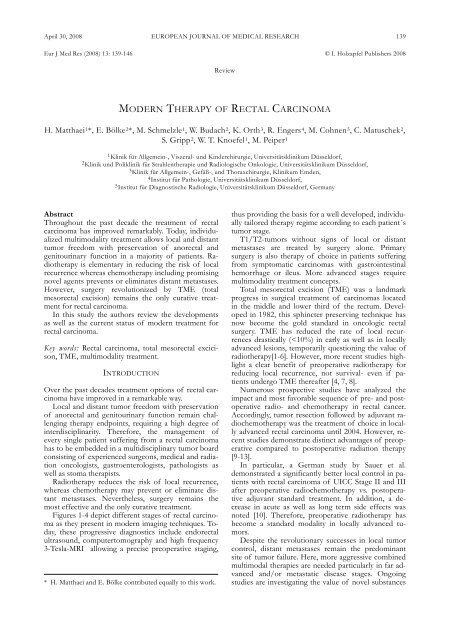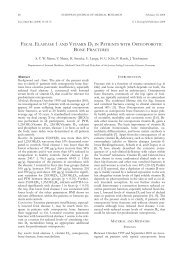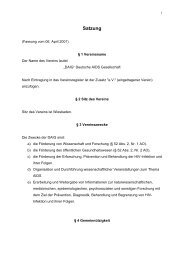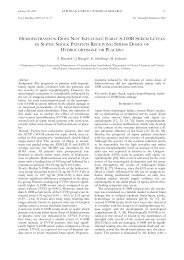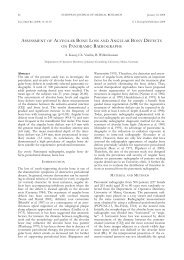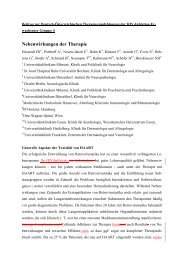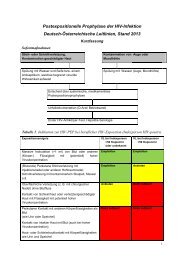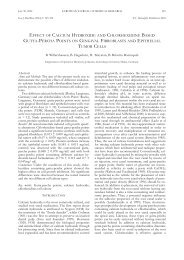MODERN THERAPY OF RECTAL CARCINOMA - ResearchGate
MODERN THERAPY OF RECTAL CARCINOMA - ResearchGate
MODERN THERAPY OF RECTAL CARCINOMA - ResearchGate
Create successful ePaper yourself
Turn your PDF publications into a flip-book with our unique Google optimized e-Paper software.
April 30, 2008<br />
Abstract<br />
Throughout the past decade the treatment of rectal<br />
carcinoma has improved remarkably. Today, individualized<br />
multimodality treatment allows local and distant<br />
tumor freedom with preservation of anorectal and<br />
genitourinary function in a majority of patients. Radiotherapy<br />
is elementary in reducing the risk of local<br />
recurrence whereas chemotherapy including promising<br />
novel agents prevents or eliminates distant metastases.<br />
However, surgery revolutionized by TME (total<br />
mesorectal excision) remains the only curative treatment<br />
for rectal carcinoma.<br />
In this study the authors review the developments<br />
as well as the current status of modern treatment for<br />
rectal carcinoma.<br />
Key words: Rectal carcinoma, total mesorectal excicison,<br />
TME, multimodality treatment.<br />
INTRODUCTION<br />
Over the past decades treatment options of rectal carcinoma<br />
have improved in a remarkable way.<br />
Local and distant tumor freedom with preservation<br />
of anorectal and genitourinary function remain challenging<br />
therapy endpoints, requiring a high degree of<br />
interdisciplinarity. Therefore, the management of<br />
every single patient suffering from a rectal carcinoma<br />
has to be embedded in a multidisciplinary tumor board<br />
consisting of experienced surgeons, medical and radiation<br />
oncologists, gastroenterologists, pathologists as<br />
well as stoma therapists.<br />
Radiotherapy reduces the risk of local recurrence,<br />
whereas chemotherapy may prevent or eliminate distant<br />
metastases. Nevertheless, surgery remains the<br />
most effective and the only curative treatment.<br />
Figures 1-4 depict different stages of rectal carcinoma<br />
as they present in modern imaging techniques. Today,<br />
these progressive diagnostics include endorectal<br />
ultrasound, computertomography and high frequency<br />
3-Tesla-MRI allowing a precise preoperative staging,<br />
EU RO PE AN JOUR NAL <strong>OF</strong> MED I CAL RE SEARCH 139<br />
Eur J Med Res (2008) 13: 139-146 © I. Holzapfel Publishers 2008<br />
Review<br />
<strong>MODERN</strong> <strong>THERAPY</strong> <strong>OF</strong> <strong>RECTAL</strong> <strong>CARCINOMA</strong><br />
H. Matthaei 1*, E. Bölke 2*, M. Schmelzle 1, W. Budach 2, K. Orth 3, R. Engers 4, M. Cohnen 5, C. Matuschek 2,<br />
S. Gripp 2, W. T. Knoefel 1, M. Peiper 1<br />
1 Klinik für Allgemein-, Viszeral- und Kinderchirurgie, Universitätsklinikum Düsseldorf,<br />
2 Klinik und Poliklinik für Strahlentherapie und Radiologische Onkologie, Universitätsklinikum Düsseldorf,<br />
3 Klinik für Allgemein-, Gefäß-, und Thoraxchirurgie, Klinikum Emden,<br />
4 Institut für Pathologie, Universitätsklinikum Düsseldorf,<br />
5 Institut für Diagnostische Radiologie, Universitätsklinikum Düsseldorf, Germany<br />
* H. Matthaei and E. Bölke contributed equally to this work.<br />
thus providing the basis for a well developed, individually<br />
tailored therapy regime according to each patient´s<br />
tumor stage.<br />
T1/T2-tumors without signs of local or distant<br />
metastases are treated by surgery alone. Primary<br />
surgery is also therapy of choice in patients suffering<br />
from symptomatic carcinomas with gastrointestinal<br />
hemorrhage or ileus. More advanced stages require<br />
multimodality treatment concepts.<br />
Total mesorectal excision (TME) was a landmark<br />
progress in surgical treatment of carcinomas located<br />
in the middle and lower third of the rectum. Developed<br />
in 1982, this sphincter preserving technique has<br />
now become the gold standard in oncologic rectal<br />
surgery. TME has reduced the rate of local recurrences<br />
drastically (
140 EUROPEAN JOURNAL <strong>OF</strong> MEDICAL RESEARCH<br />
April 30, 2008<br />
A B<br />
Fig. 1. A: Sagittal T2w MR-image of a T2 rectal cancer (arrow). B: Transverse T2w image delineates the stenosing character of<br />
the tumor without perifocal infiltration (arrow).<br />
A B<br />
Fig. 2. A: Transverse CT image of a T2 N1 rectal cancer. B: No signs of infiltration either in the perirectal fat or into the bladder<br />
(arrow: local lymph node).<br />
(such as Oxaliplatin, Capecitabine, Irinotecane, Bevacizumab<br />
or Cetuximab) and first results from preclinical<br />
and clinical studies are promising[14-28].<br />
SURGERY FOR <strong>RECTAL</strong> <strong>CARCINOMA</strong><br />
Radical surgery is the most important part in a curative<br />
concept for rectal cancer.<br />
Transanal local excision for T1-tumors has proven<br />
to be oncologically adequate for T1a situations. Residual<br />
tumor and positive lymph nodes remaining in situ<br />
led to high local recurrence rates of 20-30% [29]. Lo-<br />
cal relapse was observed in 10-23% of patients with<br />
T3 tumors treated with local resection and postoperative<br />
radiation therapy [30]. Therefore, this technique<br />
has to be reserved for selected cases (i.e. in case of severe<br />
co-morbidity). Today, radical surgery alone is the<br />
treatment of choice in patients without lymph node<br />
involvement (N0) and no signs of distant metastases<br />
(M0). However, for locally advanced tumors<br />
(T3/T4N0) the issue is not fully settled: Especially,<br />
wheather surgery in patients with gross sphincter infiltration<br />
should be supported by multimodal options including<br />
preoperative radiotherapy is discussed contro-
April 30, 2008 EUROPEAN JOURNAL <strong>OF</strong> MEDICAL RESEARCH<br />
141<br />
A B<br />
Fig. 3. A: Transverse CT image of a T3 rectal cancer: diffuse infiltration of the perirectal fat whereas uterus and the mesorectal<br />
fascia are not involved (arrowheads). B: No signs of infiltration in the perirectal fat (T3 tumor in another patient; seminal vesicles<br />
and mesorectal fascia are respected (arrowheads).<br />
A<br />
Fig. 4. A: Transverse CT image of a T4 rectal cancer with bladder infiltration (star). B: Large tumor with signs of central necrosis<br />
(sagittal reformation).<br />
verserly. No improved survival has been observed<br />
within this approach and the benefit concerning local<br />
tumor control in these patients is still on debate.<br />
Moreover, we believe that even an early diagnosed local<br />
relapse after radical surgery for T3/T4N0 carcino-<br />
mas (assessed through regular aftercare) is operable<br />
with curative intention – especially in non-radiated patients.<br />
Further studies are needed to clarify this topic.<br />
Nevertheless, T3/T4 tumors have a 5% lower risk of a<br />
local recurrence but lack of any survival benefit. If<br />
B
142 EUROPEAN JOURNAL <strong>OF</strong> MEDICAL RESEARCH<br />
April 30, 2008<br />
Fig. 5. Pathological evaluation of a representative case of rectal carcinoma treated by total mesorectal excision. A: Surgical specimen<br />
with intact circumferential resection margin; B: Typical macroscopic aspect of polypoid rectal carcinoma; C: Histological<br />
section, showing a moderately differentiated adenocarcinoma, which deeply invades into the mesorectal fat tissue, but (D) does<br />
not reach the ink-marked mesorectal resection margin.<br />
adequate postoperative follow-up is performed, even<br />
local recurrences can be detected early enough and resected,<br />
even in prior radiated areas. According to the<br />
literature, any survial benefit for preoperative radiation<br />
therapy might be achieved in T4 situations. .<br />
The most common resection techniques for rectal<br />
carcinomas depending on the site of tumor include<br />
anterior rectal resection, low anterior rectal resection<br />
and abdominoperineal resection of the rectum. Like<br />
several other centers, we prefer an intersphincteric<br />
(abdominoperianal) rectal resection with hand-sutured<br />
coloanal anastomosis for ultra low rectal cancer without<br />
signs of massive infiltration of the anal sphincter<br />
apparatus. However, this technique requires a high surgical<br />
expertise and profound experience.<br />
In terms of reconstruction, we prefer an end-to-end<br />
anastomosis or alternatively a colon-J-pouch reconstruction.<br />
A diverting ileo- or colostomy is recommended<br />
to enhance anastomotic healing and it prevents severe<br />
complications in case of a fragile anastomosis.<br />
Nevertheless, it should be noted that stomas obviously<br />
do not reduce the number of anastomotic leakage.<br />
TME was first described by Heald et al. in 1982 [3].<br />
Since then, it has had a revolutionary impact on surgi-<br />
cal therapy for carcinomas of the middle (6 to
April 30, 2008 EUROPEAN JOURNAL <strong>OF</strong> MEDICAL RESEARCH<br />
143<br />
Over the past few years, the CRM (circumferential<br />
resection margin: the plane created by dissecting the<br />
rectum from its surroundings) has become an important<br />
prognostic marker in rectal cancer. This parameter<br />
seems to be strongly associated with local recurrence<br />
and survival. It has been shown that apart from<br />
adequate surgery, the tumor freedom of the CRM depends<br />
on neoadjuvant therapy [33]. Not surprisingly,<br />
histopathological investigations revealed that TME<br />
was able to reduce the rate of CRM involvement below<br />
10% [5]. However, to allow proper evaluation of<br />
the CRM by the pathologist, it is essential that the<br />
CRM remains intact during the surgical procedure.<br />
Figures 5A-D show a representative rectal carcinoma<br />
treated by TME with complete CRM.<br />
Whether all patients with rectal cancer should undergo<br />
TME regardless of tumor stage and site is still<br />
on debate. For tumors located in the middle or distal<br />
rectum the excision of the entire mesorectum is<br />
mandatory.<br />
For proximal rectal carcinomas (12 to 16 cm) as<br />
well as for tumors of the rectosigmoid, a partial<br />
mesorectal excision (PME) seems to be sufficient. The<br />
PME delivers equal oncologic outcomes and a reduced<br />
risk of surgery associated complications such as anastomotic<br />
leakage or nerve damage [34].<br />
RADIO<strong>THERAPY</strong><br />
Radiotherapy was formerly implemented within palliative<br />
treatment concepts for advanced rectal cancer. Today<br />
it is an essential part of standard treatment in order<br />
to reduce the rate of local recurrence. Local relapses<br />
in rectal cancer are often difficult to handle and<br />
overall they have a severe impact on the patient`s quality<br />
of life.<br />
Not only quality of surgery has improved over the<br />
past decades. Also radiotherapy has ameliorated<br />
steadily. For example, an area-wide implementation of<br />
linear accelerators and 3-D treatment planning have<br />
increased effectiveness and reduced the side-effects of<br />
radiotherapy.<br />
Today, there is evidence that preoperative radiotherapy<br />
is more effective than postoperative radiotherapy<br />
[9-13]. The disadvantages of postoperative radiotherapy<br />
comparing to preoperative radiation may be explained<br />
by different hypotheses:<br />
First, the interval between operation and radiotherapy<br />
gives potentially remaining tumor cells time to<br />
proliferate. Second, a reduced postoperative blood circulation<br />
in the operating field with subsequent hypooxygenation<br />
is believed to increase radioresistance. Finally,<br />
adverse effects have proven to be higher after<br />
adjuvant radiation therapy.<br />
For preoperative radiation, a distinct dosage-effect<br />
relation was observed. As an example, cumulative doses<br />
of 20 Gy showed no significant improvements<br />
whereas patients treated with doses of >32 Gy had<br />
significant fewer local recurrences [35].<br />
As mentioned, TME was able to reduce local recurrence<br />
rates dramatically, questioning the necessity of<br />
radiotherapy. However, a large study from the Netherlands<br />
(n=1861) revealed a significantly lower local recurrence<br />
rate (5.6%) in patients treated with preopera-<br />
tive radiotherapy and TME compared to the local recurrence<br />
rate after TME alone (10.9%). The effect was<br />
most obvious in UICC stage III rectal carcinomas as<br />
well as in tumors of the middle and lower rectum [4].<br />
Recent results from the MRC-CR-07 study underlined<br />
the benefit of combining TME with preoperative<br />
radiotherapy. In this trial, preoperative radiotherapy<br />
with 5x5 Gy was compared with postoperative radiotherapy<br />
in patients with positive circumferential resection<br />
margin (CRM+). The latter had a significantly<br />
higher local recurrence rate and a significantly reduced<br />
disease free survival (DFS) [7, 8].<br />
According to these findings, neoadjuvant radiotherapy<br />
has become the gold standard.<br />
Solely or in combination with chemotherapy, it is<br />
considered as the treatment of choice in rectal cancer<br />
in order to minimize the risk of a local recurrence.<br />
CHEMO<strong>THERAPY</strong> AND MULTIMODALITY<br />
TREATMENT<br />
In the 1980ies, various American studies outlined the<br />
superiority of the combination of surgery with radiotherapy<br />
and chemotherapy versus the application of<br />
one modality alone in the treatment of rectal cancer<br />
[36]. This finding was supported by additional latter<br />
studies [11]. Today it seems evident that best clinical<br />
results are achieved if both modalities are applicable<br />
[37-41].<br />
As local relapse could be drastically reduced by<br />
TME and radiotherapy, distant metastases are today<br />
the predominant site of tumor failure, generating an<br />
urgent need for more effective systemic drugs in the<br />
adjuvant setting.<br />
In the past, a variety of protocols in order to evaluate<br />
the optimal schedule and sequence of radiotherapy<br />
and 5-FU/ folinic acid based chemotherapy have been<br />
presented.<br />
The EORTC-22921 trial compared outcomes after<br />
neoadjuvant conventional fractionized radiation (45<br />
Gy) with or without 5-FU/ folinic acid. Postoperatively,<br />
patients were treated either with or without adjuvant<br />
chemotherapy. Herein, remission rates as well as<br />
local tumor control were significantly higher in the<br />
combined radiochemotherapy arm whereas no significant<br />
survival benefit could be assessed [42].<br />
Similar results were revealed in a French study that<br />
included patients with cT3-, T4- Nx-patients. Here,<br />
patients treated with neoaduvant radiochemotherapy<br />
(45 Gy and 5-FU/ folinic acid) also had a lower local<br />
recurrence rate of 8% as compared to patients that<br />
underwent only radiotherapy in the neoadjuvant setting<br />
[22]<br />
Accordingly, a combined neoadjuvant radio chemo -<br />
therapy seems more effective in patients with cT3-,<br />
T4- Nx patients than radiation alone, even if chemo -<br />
therapy is given postoperatively.<br />
Today, a set of novel chemotherapeutic agents has<br />
been proven more effective than 5-FU alone in advanced<br />
colorectal disease. However, results from larger<br />
studies are not available for all of these substances.<br />
Capecitabine (Xeloda‚) represents an orally administered<br />
fluoropyrimidine. Capecitabine is converted to<br />
5-FU intrahepatically and in the tumor cells them-
144 EUROPEAN JOURNAL <strong>OF</strong> MEDICAL RESEARCH<br />
April 30, 2008<br />
selves by the enzyme “thymidine phosphorylase”. Preclinical<br />
studies have identified an activation of this enzyme<br />
and therefore an improved antitumor effect<br />
through radiotiotherapy [25]. Moreover, it could be<br />
demonstrated that capecitabine applied in metastatic<br />
colorectal cancer had comparable effects on tumor relapse,<br />
toxicity and survival as compared to conventional<br />
5-FU/ folinic acid regimes [19-21]. No data concerning<br />
phase III studies (such as NSABP-R04 trial)<br />
are available, so far.<br />
Oxaliplatin (Eloxatin‚) together with fluorouracil<br />
and folinic acid it is part of the FOLFOX scheme for<br />
the treatment of colorectal cancer. Compared to cisplatin<br />
oxaliplatin showed an improved antitumor activity<br />
and proved to be a radiosensitizer [24]. However,<br />
the exact molecular mechanisms of action of oxaliplatin<br />
remain elusive. Whether it should be administered<br />
before or after radiation is still on discussion. In<br />
a phase III trial in colorectal cancer patients it has<br />
been shown that combining oxaliplatin with 5-FU/<br />
folinic acid is more beneficial concerning tumor progression<br />
than 5-FU/ folinic acid alone [23]. Also in<br />
combination with preoperative radiation oxaliplation<br />
showed no increased side-effects [18].<br />
Irinotecane (Camptosar‚) is a topoisomerase-1-inhibitor<br />
that blocks DNA replication as well as transcription.<br />
Together with 5-FU, folinic acid, irinotecane<br />
is used for metastatic colorectal cancer within the<br />
FOLFIRI scheme. Severe diarrhea and a strong suppression<br />
of the immune system are two major side-effects<br />
of irinotecane. Nevertheless, experiences from<br />
phase I/II of combined-modality schemes integrating<br />
Irinotecane show that toxicity is overall tolerable and<br />
remission rates as well as outcomes are promising<br />
[27].<br />
Cetuximab (Erbitux‚) is a chimeric monoclonal antibody<br />
directed against the epidermal growth factor receptor<br />
(EGFR). The latter is over-expressed in colorectal<br />
cancer cells leading to increased proliferation,<br />
angiogenesis, migration and inhibition of apoptosis.<br />
Results from first line phase II trials of combined<br />
modality schemes integrating Cetuximab are hopeful<br />
and showed high response rates [15, 16]. Similarly, in<br />
recent phase III trials, including patients with<br />
chemotherapy-refractory metastatic colorectal cancer,<br />
a new fully humanized monoclonal EGFR antibody,<br />
referred to as Panitumumab, was shown to significantly<br />
increase progression free survival [43, 44]. Interestingly,<br />
the therapeutic success or failure of Panitumumab<br />
and/or Cetuximab seems to depend largely on the<br />
mutation status of the KRAS oncogene. Whereas up<br />
to 33% of tumors with wild type KRAS responded to<br />
this therapeutic approach, none of the tumors with activating<br />
mutations in codon 12 or 13 of KRAS did [45,<br />
46]. Thus, analysis of the KRAS mutation status<br />
seems to be predictive in terms of whether or not a<br />
therapeutic approach with Panitumumab and/or Cetuximab<br />
is justified and consequently, approval of<br />
Panitumumab in colorectal cancer therapy by the European<br />
Medicines Agency (EMEA) is exclusively restricted<br />
to tumors with wild type KRAS.<br />
Bevacizumab (Avastin‚) is also a monoclonal antibody<br />
directed against the vascular endothelial growth<br />
factor receptor (VEGFR). It inhibits the formation of<br />
new blood vessels by targeting the function of VEGF.<br />
Moreover, Bevacizumab seems to enhance radiotherapy<br />
[17]. One important side effect in some patients is<br />
hypertension. Phase I/II studies integrating Bevacizumab<br />
in combined modality schemes for rectal have<br />
proven to be tolerable, with encouraging response<br />
rates [14].<br />
CONCLUSION AND CURRENT PRACTICAL<br />
ADVICE<br />
The treatment of rectal carcinoma requires a multidisciplinary<br />
team of experts.<br />
According to findings from ever improving diagnostics,<br />
every patient should be referred to an individual,<br />
tailored therapy.<br />
Therein, radical surgery is the most important curative<br />
part. TME (total mesorectal excision) has had a<br />
revolutionary impact on local tumor control and has<br />
become the standard technique in middle or low rectal<br />
carcinomas. PME (partial mesorectal excision) has<br />
proved to be appropriate in proximal rectal tumors.<br />
Distal sphincter infiltrating tumors are treated by abdomino<br />
perineal rectum extirpation. However, ultralow<br />
abdominoperanal rectal resection with sphincter<br />
preservation should be applied wherever feasible.<br />
The detailed postoperative histopathological investigation<br />
includes the assessment of the CRM by an experienced<br />
pathologist. The results contribute to further<br />
treatment decisions.<br />
In localized rectal cancer (T1 to T3 and N0), radical<br />
surgery alone seems to be sufficient. However, in<br />
T4N0 tumors the issue is not completely settled as<br />
preoperative radiotherapy does not improve survival<br />
in these patients and the effect on long-term local<br />
control is limited. However, in far advanced tumors<br />
(uT3n+) a combined multimodality scheme with preoperative<br />
radiochemotherapy implementing new systemic<br />
drugs (such as Capecitabine, Oxaliplatin,<br />
Irinotecan, Cetuximab, Bevacizumab) is recommended.<br />
Phase I/II studies revealed promising results. Now,<br />
there is a need for phase III studies (Germany:<br />
CAO/ARO/AIO-04; Europe: PETACC6; USA:<br />
NSAPB-R04, E5204 Intergroup Trial) to examine<br />
whether these approaches are superior to 5-FU based<br />
combined modality and to assess long-term toxicity.<br />
Concluding, no adjuvant scheme can compensate<br />
for inadequate surgery.<br />
REFERENCES<br />
1. Heald RJ, Moran BJ, Ryall RD: Rectal cancer: the Basingstoke<br />
experience of total mesorectal excision, 1978-<br />
1997. Arch Surg. 1998; 133(8): 894-9.<br />
2. Bulow S, Christensen IJ, Harling H, Kronborg O, Fenger<br />
C, Nielsen HJ: Recurrence and survival after mesorectal<br />
excision for rectal cancer. Br J Surg. 2003; 90: 974-80.<br />
3. Heald RJ, Husband EM, Ryall RD: The mesorectum in<br />
rectal cancer surgery-the clue to pelvic recurrence? Br J<br />
Surg. 1982; 69: 613-6.<br />
4. Kapiteijn E, Marijnen CA, Nagtegaal ID, Putter H, Steup<br />
WH, Wiggers T, Rutten HJ, Pahlman L, Glimelius B, van<br />
Krieken JH, Leer JW, van de Velde CJ: Preoperative radiotherapy<br />
combined with total mesorectal excision for<br />
resectable rectal cancer. N Engl J Med. 2001; 345: 638-46.
April 30, 2008 EUROPEAN JOURNAL <strong>OF</strong> MEDICAL RESEARCH<br />
145<br />
5. Wibe A, Rendedal PR, Svensson E et al.: Prognostic significance<br />
of the circumferential resection margin following<br />
total mesorectal excision for rectal cancer. Br J Surg.<br />
2002;89: 327-34.<br />
6. Chau I, Brown G, Cunningham D, et al.: Neoadjuvant<br />
capecitabine and oxaliplatin followed by synchronous<br />
chemoradiation and total mesorectal excision in magnetic<br />
resonance imaging-defined poor risk rectal cancer. J Clin<br />
Oncol. 2006; 24(4): 668-74.<br />
7. Quirke P, Sebag-Montefiore D, Steele R, et al.: Local recurrence<br />
after rectal cancer resection is strongly related to<br />
the plane of surgical dissection and is further reduced by<br />
pre-operative short course radiotherapy. Preliminary results<br />
of the Medical Research Council (MRC) CR07 trial.<br />
J Clin Oncol. 2006; 24(18Suppl): A-3512.<br />
8. Sebag-Montefiore D, Steele R, Quirke P, et al: Routine<br />
short course pre-op chemoradiotherapy for resectable<br />
rectal cancer? Preliminary results of the MRC CR07 randomized<br />
trial. J Clin Oncol. 2006; 24(18Suppl): A-3511.<br />
9. Sauer R: Adjuvant and neoadjuvant radiotherapy and concurrent<br />
radiochemotherapy for rectal cancer. Pathol Oncol<br />
Res. 2002; 8: 7-17.<br />
10. Sauer R, Becker H, Hohenberger W, et al.: Preoperative<br />
versus postoperative chemoradiotherapy for rectal cancer.<br />
N Engl J Med. 2004; 351: 1731-40.<br />
11. Sauer R, Dunst J: The consensus conference on the adjuvant<br />
therapy of rectal carcinoma. A commentary from the<br />
radio-oncology viewpoint. Strahlenther Onkol. 1994; 170:<br />
427.<br />
12. Sauer R, Fietkau R, Wittekind C, et al.: Adjuvant vs. neo -<br />
adjuvant radiochemotherapy for locally advanced rectal<br />
cancer: the German trial CAO/ARO/AIO-94. Colorectal<br />
Dis. 2003; 5: 406-15.<br />
13. Pahlman L, Glimelius B: Pre- or postoperative radiotherapy<br />
in rectal and rectosigmoid carcinoma. Report from a<br />
randomized multicenter trial. Ann Surg. 1990; 211: 187-95.<br />
14. Czito BG Bendell JC, Willett CG, et al.: Bevacizumab, oxaliplatin,<br />
and capecitabine with radiation therapy in rectal<br />
cancer: Phase I trial results. Int J Radiat Oncol Biol Phys.<br />
2007; 68 (2): 472-8.<br />
15. Diaz Rubio E, Tabernero J, van Cutsem E, et al.: Cetuximab<br />
in combination with oxaliplain/5-fluorouracil<br />
(5FU)/folinic acid (FA) (FOLFOX-4) in the first-line<br />
treatment of patients with epidermal growth factor receptor<br />
(EGFR)-expressing metastatic colorectal cancer: An<br />
international phase II study. J Clin Oncol ASCO Annual<br />
Meeting Proceedings. 2005; 23, No. 16S, Part I of II<br />
(June I Supplement):3538.<br />
16. Rosenberg AH, Loehrer PJ, Needle MN, Waksal H, Hollywood<br />
E, Ramos L, Saltz LB.: Erbitux (IMC-C225) plus<br />
weekly irinotecan (CPT-11), fluorouracil (5FU) and leucovorin<br />
(LV) in colorectal cancer (CRC) that express the<br />
epidermal groth factor receptor (EGFr). Proc Am Soc<br />
Clin Oncol. 2002; 21.<br />
17. Willet CG, Kozin SV, Duda DG, et al.: Combined vascular<br />
endothelial growth factor-targeted therapy and radiotherapy<br />
for rectal cancer: theory and clinical practice.<br />
Semin Oncol. 2006; 33 (Suppl. 10): 35-40.<br />
18. Gerard JP, Chapet O, Nemoz C, et al.: Preoperative concurrent<br />
chemoradiotherapy in locally advanced rectal cancer<br />
with high-dose radiation and oxaliplatin-containing<br />
regimen: the Lyon R0-04 phase II trial. J Clin Oncol.<br />
2003; 21: 1119-24.<br />
19. Das P, Lin EH, Bhatia S, et al.: Preoperative chemoradioherapy<br />
wih capecitabine versus protracted infusion 5-fluorouracil<br />
for rectal cancer: a matched-pair analysis. Int J<br />
Radiat Oncol Biol Phys. 2006; 66: 1378-83.<br />
20. Kim DY, Jung KH, Kim TH, et al.: Comparison of 5-fluooruracil/leucovorin<br />
and capecitabine in preoperative<br />
chemoradioherapy for locally advanced rectal cancer. Int<br />
J Radiat Oncol Biol Phys. 2007: 378-84.<br />
21. Twelves C, Wong A, Nowacki MP et al.: Capecitabine as<br />
adjuvant treatment for stage III colon cancer. N Engl J<br />
Med. 2005; 352: 2696-704.<br />
22. Gerard JP, Conroy T., Bonnetain F., et al.: Preoperative<br />
radiotherapy with or without concurrent fluorouracil and<br />
leucovorin in T3-T4 rectal cancers: results of FFCD 9203.<br />
J Clin Oncol. 2006; 24: 4620.<br />
23. Giacchetti S, Perpoint B, Zidani R, et al: Phase III multicenter<br />
randomized trial of oxaliplatin added to<br />
chronomodulaed. J Clin Oncol. 2000; 18: 136-47.<br />
24. Cividalli A CF, Lividi E, et al.: Radiosensitization by oxaliplatin<br />
in a mouse adenocarcinoma: influence of treatment<br />
and schedule. Int J Radiat Oncol Biol Phys. 2002;<br />
1092-98.<br />
25. Sawada N, Ishikawa T, Sekiguchi F, et al.: X-ray irradiation<br />
induces thymidine phosphorylase and enhances the<br />
efficiacy of capecitabine (Xeloda). Clin Cancer Res. 1999;<br />
5: 2948-53.<br />
26. Fietkau R, Barten M, Klautke G, et al.: Postoperative<br />
chemotherapy may not be necessary for patients with<br />
ypN0-category after neoadjuvant chemoradiotherapy of<br />
rectal cancer. Dis Colon Rectum. 2006; 49: 1284-92.<br />
27. Klautke G, Feyerherd P, Ludwig K, et al.: Intensified<br />
concurrent chemoradiotherapy with 5-fluorouracil and<br />
irinotecan as neoadjuvant treatment in patients with locally<br />
advanced rectal cancer. Br J Cancer. 2005; 92: 1215-20.<br />
28. Rutten H, Sebag-Montefiore D, Glynne-Jones R, et al.:<br />
Capecitabine, oxaliplatin, radiotherapy, and excision<br />
(CORE) in patients with MRI-defined locally advanced<br />
rectal adenocarcioma: results of an international multicenter<br />
phase II study. J Clin Oncol. 2006; 24(18suppl): 3528.<br />
29. Cohen A, Minsky BD, Schilsky R: Cancer of the Rectum.<br />
ed 5th, Philadelphia, Lippincott-Raven, 1997.<br />
30. Budach W: New aspects of adjuvant radiotherapy in primarily<br />
resectable rectal cancer. Onkologie. 2002; 25: 223-<br />
30.<br />
31. Cecil TD, Sexton R, Moran BJ, et al.: Total mesorectal excision<br />
results in low local recurrence rates in lymph nodepositive<br />
rectal cancer. Discussion by Rothenberger DA.<br />
Dis Colon Rectum. 2004; 47: 1145.<br />
32. Martling AL, Holm T, Rutqvist LE, et al.: Effect of surgical<br />
training programme on outcome of rectal cancer in<br />
the county of stockholm. Stockholm Colorectal Cancer<br />
Study Group. Basingstoke Bwel Cancer Research Project.<br />
Lancet. 2000; 356 (9224): 93-6.<br />
33. Gosens MJ, Klaassen RA, Tan-Go I, et al.: Circumferential<br />
margin involvement is the crucial prognostic factor after<br />
multimodality treatment in patients with locally advanced<br />
rectal carcinoma. Clin Cancer Res. 2007; 13: 6617-23.<br />
34. Law WL, Chu KW: Anterior resection for rectal cancer<br />
with mesorectal excision: a prospective evaluation of 622<br />
patients. Ann Surg. 2004; 240 (2): 260-8.<br />
35. Camma C, Giunta M, Fiorica F, et al.: Preoperative radiotherapy<br />
for resectable rectal cancer: A meta-analysis.<br />
JAMA. 2000; 284:1008-15.<br />
36. Wolmark N, Fisher B: An analysis of survival and treatment<br />
failure following abdominoperineal and sphinctersaving<br />
resection in Dukes' B and C rectal carcinoma. A<br />
report of the NSABP clinical trials. National Surgical Adjuvant<br />
Breast and Bowel Project. Ann Surg. 1986; 204:<br />
480-9.<br />
37. Prolongation of the disease-free interval in surgically<br />
treated rectal carcinoma. Gastrointestinal Tumor Study<br />
Group. N Engl J Med. 1985; 312: 1465-72.<br />
38. Douglass HO, Jr., Moertel CG, Mayer RJ, et al.: Survival<br />
after postoperative combination treatment of rectal cancer.<br />
N Engl J Med. 1986; 315: 1294-5.<br />
39. Fisher B, Wolmark N, Rockette H, et al.: Postoperative<br />
adjuvant chemotherapy or radiation therapy for rectal<br />
cancer: results from NSABP protocol R-01. J Natl Cancer<br />
Inst. 1988; 80: 21-9.
146 EUROPEAN JOURNAL <strong>OF</strong> MEDICAL RESEARCH<br />
April 30, 2008<br />
40. Krook JE, Moertel CG, Gunderson LL, et al.: Effective<br />
surgical adjuvant therapy for high-risk rectal carcinoma.<br />
N Engl J Med. 1991; 324: 709-15.<br />
41. Tveit KM, Wiig JN, Olsen DR, et al.: Combined modality<br />
treatment including intraoperative radiotherapy in locally<br />
advanced and recurrent rectal cancer. Radiother Oncol.<br />
1997; 44: 277-82.<br />
42. Bosset JF, Collette L, Calais G, et al.: Chemotherapy with<br />
preoperative radiotherapy in rectal cancer. N Engl J Med.<br />
2006; 355(11): 1114-23.<br />
43. Siena S, Peeters M, Van Cutsem E, et al.: Association of<br />
progression-free survival with patient-reported outcomes<br />
and survival: results from a randomised phase 3 trial of<br />
panitumumab. Br J Cancer. 2007; 97: 1469-74.<br />
44. Van Cutsem E, Peeters M, Siena S, et al.: Open-label<br />
phase III trial of panitumumab plus best supportive care<br />
compared with best supportive care alone in patients with<br />
chemotherapy-refractory metastatic colorectal cancer. J<br />
Clin Oncol. 2007; 25: 1658-64.<br />
45. Amado RG, Wolf M, Peeters M, et al.: Wild-type KRAS<br />
is required for panitumumab efficacy in patients with<br />
metastatic colorectal cancer: Results from a randomized,<br />
controlled trial. Presented at the 14th Biannual European<br />
Cancer Conference (ECCO); Sep 23-27, 2007, Barcolona,<br />
Spain. Abstract 0007.;5 (4-6) 7<br />
46. De Roock W, Piessevaux H, De Schutter J, et al.: KRAS<br />
wild-type state predicts survival and is associated to early<br />
radiological response in metastatic colorectal cancer treated<br />
with cetuximab. Ann Oncol. 2008; 19: 508-15.<br />
Received: March 28, 2008 / Accepted: April 9, 2008<br />
Address for correspondence:<br />
PD Dr. med. Matthias Peiper<br />
Klinik für Allgemein-, Viszeral- und Kinderchirurgie<br />
Universitätsklinikum Düsseldorf<br />
Moorenstr. 5<br />
40225 Düsseldorf<br />
Germany.<br />
Fax: +49-(0)211-8119099<br />
Tel.: +49-(0)211-8116398<br />
E-mail: matthias.peiper@uni-duesseldorf.de


